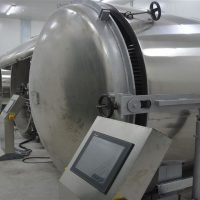Have you ever wondered how astronaut meals are prepared? You are wrong if you think of the usual methods of sending regular food on Earth to space. Because astronaut meals are designed according to the needs of human physiology changing in space, suitable for a non-gravity environment, and easy to prepare. In addition, it is also important that the food takes up little space and has a long shelf life since huge pantries cannot be added to the spacecraft.
When preparing astronaut meals, several problems need to be resolved. This is the reason why experts in this field develop astronaut dishes. So, how did scientists specialising in this field find a solution for feeding astronauts? To answer this question, it is necessary to look at the studies on space food.
Studies on Space Food
When you think of astronaut food research, NASA comes to mind, but today, there are also a few private space research institutions. We know that official space research units and private institutions of other countries, especially NASA, conduct different studies on the nutrition of astronauts in space.
We say “work” rather than “cooking” because everything we know about nutrition changes in space. Because, with gravity and other differentiating factors, there are some changes in space for human physiology and requirements.
The department at NASA that prepares these special dishes is called the Space Food Systems Laboratory. In most studies, studies done by NASA are cited as references. So, what has NASA done and is doing about astronaut meals? To answer this question, we must look at what has changed from the first meals in space to today.
The Evolution of Astronaut Meals
To understand this subject well, it is necessary to go to the beginning of the space adventures of humanity first. April 12, 1961, is very important in this respect. The first human went into space on this date. Russian Yuri Gagarin became the first person to go into space in a vehicle called Vostok 1.
After that, as it is known, a great space race started between the USA and the Russians. That race caused this field to gain great momentum today. So, what changes have occurred in the astronaut meals placed in vehicles for people sent into space since 1961?
The answer to this question is closely related to changing technology and using it in the food industry. The first foods eaten in space by astronauts in the 1960s were products such as crackers or dried bread. Liquid liquids and foods that require cutlery were not preferred in a gravity-free environment.
Over time, different solutions were produced by changing the packaging. The need for long-term good nutrition for astronaut meals was effective. Today, freeze-dried foods are mostly preferred. So, what does freeze-drying mean?
Food Drying Methods and Freeze Drying
When developing content focusing on astronaut meals, it is essential to discuss the advanced technique of lyophilisation, a specialised process known as freeze-drying. This technology surpasses traditional freezing, enabling food preservation for extensive periods, particularly crucial for space missions where the shelf life of provisions is paramount.
The lyophilisation process involves freezing the food and reducing the surrounding pressure to allow the frozen water in the food to sublime directly from the solid to the gas phase. This process maintains the food’s cellular structure, significantly more effectively preserving its nutritional content, flavour, and aroma than standard freezing methods.
Astronauts often rely on freeze-dried foods during their missions, as they are lightweight, have a long shelf life, and require minimal preparation. The freeze-dried food is packaged in a vacuum-sealed pouch to prevent the ingress of moisture, ensuring the preservation of its quality. When it’s time to eat, astronauts simply rehydrate the food with water, reviving its original texture and taste while maintaining its nutritional integrity.
In addition, there are more suitable methods for some food. For example, you may find that it loses its properties when you freeze and thaw chocolate. However, freeze-dried food for astronauts still preserves its essential place when eating in space.
One of the methods of preserving food is canning. This method is also highly preferred, but it is only possible to can some products. In addition, the shelf life of canned food is limited, and there are some changes in foods according to the fresh form.
Drying in the sun and drying with sulphurisation are preferred food storage options. In recent years, freeze-drying has come to the fore as the storage method that will preserve the value of foods at the highest rate. This method is the best alternative for maintaining nutrition in astronaut meals because it keeps its colour, smell, taste, and nutritional values, takes up little space, and is very easy to consume. It is also becoming increasingly common for home and professional kitchens.
What Do Astronauts Eat in Space?
Astronauts can consume almost any food in space. However, foods need to go through some processes. These processes aim to be careful about the bacteria and fungus species we will carry into space, ensure that the astronauts are fed adequately, and offer products that are easy to prepare, take up little space, and last for a long time. The foods used in the three methods are consumed in the area to meet all these features. These methods can be listed as follows:
- Freeze-dried reconstituted foods,
- Thermo-stabilised foods,
- Irradiated foods
Freeze Drying Food
Freeze dryer machines: While preserving the value, colour, smell, and taste of foods, they take up less space and keep them fresh longer. For this reason, freeze-dried space food is the most preferred method for preparing astronaut meals. In this way, almost any food, such as fruits, vegetables, meat, fish, chocolate, cheese, and milk, can be stored.
Thermostabilizing Food
This method is based on applying heat treatment to food. Soups packed in bags, like noodles and pasta, desserts, and other dishes, are thermostabilised and prepared for consumption in space.
Irradiation of Food
Especially for meat products, irradiation is a very common storage method. Irradiation is also done for the meat in the astronaut dishes. Heat treatment applied to foods such as red meat, chicken, and turkey allows them to be stored at room temperature. In addition, heating after opening the package is sufficient for consumption.
Preparation of Astronaut Meals
It is generally easy to prepare the food put into the spacecraft in ready form by the above methods. To prepare astronaut meals, adding water to the food or heating it is often sufficient. However, there are more desirable options than the heating method in spacecraft. This is why adding water in preparing astronaut meals is much more preferable. For this reason, experts who develop space dishes focus on freeze-drying foods for astronauts.
Today’s research shows insufficient efficiency for long-term manned travel by spacecraft. However, the work continues. In the coming years, methods such as growing plants in spacecraft and obtaining food from 3D printing will become more applicable.
You can reach our previous article at https://liyolife.com/en/freeze-dried-taxidermy/







